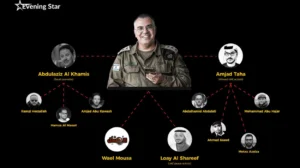After more than 16 months of intense military operations in Gaza, Israel has failed to achieve its primary objective: the complete elimination of Hamas. Despite widespread destruction, thousands of casualties, and severe humanitarian crises, Hamas remains entrenched in Gaza, continuing its resistance against Israeli forces. Facing this reality, Israel appears to be shifting tactics—moving toward Plan B, which involves fueling internal dissent against Hamas through psychological warfare, social media campaigns, and the mobilization of Palestinian activists abroad.
The Failure of Military Operations
Since October 7, 2023, when Hamas launched a surprise attack on southern Israel, killing approximately 1,200 people and taking over 240 hostages, Israel has waged one of its most aggressive military campaigns in Gaza. The Israeli Defense Forces (IDF) have carried out relentless airstrikes and ground operations, displacing nearly 2 million Palestinians and killing over 50,000 people, according to Gaza’s Health Ministry.

However, despite the heavy toll, Hamas’ leadership remains intact, and its fighters continue to engage in guerrilla warfare. The Israeli military has struggled to dismantle Hamas’ vast tunnel network, and the group has retained significant influence over Gaza’s population. With no clear victory in sight, Israel is now exploring alternative strategies to weaken Hamas from within.
Plan B: Inciting Civil Unrest Against Hamas
According to well informed sources in IDF, Israel has activated a crisis cell tasked with undermining Hamas’ rule by encouraging protests and civil disobedience in Gaza. This will be a step to conduct mass expulsion of Gaza population to Egypt and other countries. This cell is reportedly managed by Israeli army spokesman Avichay Adraee, alongside regional influencers, including Amjad Taha (Ahwazi-UAE activist), Abdulaziz Al Khamis (Saudi journalist), and Loay Al Shareef (UAE peace activist).
The cell is also coordinating with Palestinian activists based in Europe and Egypt, who are amplifying anti-Hamas messaging on social media. Key figures involved include Ramzi Herzallah (Belgium), Hamza Al Massri (Belgium-Turkey), Amjad Abu Kawash (London), Abdalhamid Abdulati (Egypt), Ahmad Saeed (Egypt), Mohammad Abu Hajar (Belgium), and Ibrahim Asaliya (London) and Wael Mousa (Turkey)
These activists have been promoting narratives highlighting Hamas’ failures in governance, its harsh crackdowns on dissent, and the suffering of Gazans under both war and Hamas’ rule.
Protests Erupt in Gaza
Yesterday, large protests erupted across Gaza, with demonstrators chanting against Hamas and calling for an end to the war. According to sources within the crisis cell, these protests are expected to grow in the coming days, potentially escalating into a full-blown civil uprising.
Hamas has historically suppressed internal opposition, but the prolonged war has exacerbated public frustration. Many Gazans blame Hamas for provoking Israel’s devastating response, while others criticize the group for diverting resources away from civilians and toward military efforts.
Social Media and Psychological Warfare
The crisis cell is heavily relying on social media campaigns to turn Gazans against Hamas. Platforms like Twitter (X), Telegram, and Facebook are being used to circulate videos of protests, testimonies from disillusioned Gazans, and critiques of Hamas’ leadership.
The strategy mirrors tactics seen in other conflicts, where external actors exploit local grievances to destabilize ruling factions. If successful, this could lead to internal clashes between Hamas and rival factions or civilian groups, weakening the movement without direct Israeli military intervention.
While Israel’s Plan B presents a new approach, it carries significant risks. Hamas has a well-established security apparatus that has historically crushed dissent. Many Gazans, despite their frustrations, may still see Hamas as their only defender against Israeli occupation. If protests turn violent, Hamas could intensify its crackdown, leading to further bloodshed.
If the crisis cell succeeds in mobilizing enough opposition, Gaza could see a power struggle between Hamas and other factions, such as Fatah or independent armed groups. This could either lead to Hamas’ downfall or further fracture Palestinian unity.
To maximize the reach and impact of the campaign, the group would collaborate indirectly with influential social media voices such as Motaz Azaiza, a prominent Palestinian journalist and activist with a massive global following as well as other local outlets and digital advocates. According to the source this would give campaign immediate visibility among key audiences, leveraging their credibility and grassroots networks. In return for agreed funds, these influencers could share firsthand testimonies, amplify calls to action, and mobilize their followers to support the cause.

